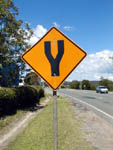
Caution Tuning Fork? A common sign in Australia.
Signs
Tuning Forks

A common caution sign by the side of Australian roads looks like it cautions drivers about tuning forks. And well it should! Tuning forks produce two loud tones, a low pitch note, its fundamental, which is the one it is labeled as producing, and a higher pitch note known as the "clang" tone. The high pitch clang tone is over six times higher in frequency than the fundamental tone of the tuning fork.

The stem of the tuning fork is an antinode of vibration for the fundamental frequency, it is a node for the clang tone. Thus if you strike a tuning fork and start it ringing you can hear the fundamental tone by touching the tuning fork stem to your skull or to a table top.


Right, one extreme of the motion of a tuning fork playing its
fundamental note.
Left, one extreme of the motion of a tuning fork playing the clang
tone.
The caution sign also serves as a reminder to play the tuning fork by striking it against something reasonably soft, like the sole or heel of your shoe. If you strike it against a hard surface like concrete you can cut gouges out of the tuning fork and change its tuning.
You can use the front fork of a bicycle as a tuning fork. Get one from your local bicycle repair shop. Strike it against the ground and listen to it vibrate with your ear near the ends of the two tines, then move your ear down the gap between the tines toward the stem. Yu'll hear the fundamental loudest near the ends of the times then as you progress toward the stem the fundamental will fade away and you will hear the clang tone. The ends of the tines are the antinodes of the fundamental and the clang tone, but as you move down the gap a bit you come to a place which is the node of motion for the clang tone.
|
Scientific Explorations with Paul Doherty |
|
24 April 2002 |